The Best Outdoor Activities in Ecuador: A Travel Guide for Adventurers
Did you know outdoor activities in Ecuador can include mountain biking, white-water rafting, and scrambling down waterfalls? What about high-altitude trekking in Cotopaxi National Park or crossing a Tibetan bridge swinging over the Amazon rainforest? Then there’s humpback whale watching in Machalilla National Park or meeting blue-footed boobies on Isla de La Plata!
With its biodiversity surpassing that of Costa Rica, plus charming colonial cities like Cuenca and Quito, Ecuador is an adventure lover’s paradise! In addition, there is so much more to Ecuador than simply going to the Galapagos. In this blog, you will learn about:
- Ecuador’s Biological and Cultural History
- Getting To Ecuador and Getting Around
- Best Outdoor Activities in Ecuador and Places to Stay
- Safety Precautions, Altitude Sickness & Travel Vaccines
- Ecuador’s Best Food & Final Thoughts on Travel
We had the most incredible journey across Ecuador and met wonderful locals who taught us about their rich history and culture. We left feeling grateful and could not wait to share our experience with others. So brush up on your Spanish, and vamos, let’s go!
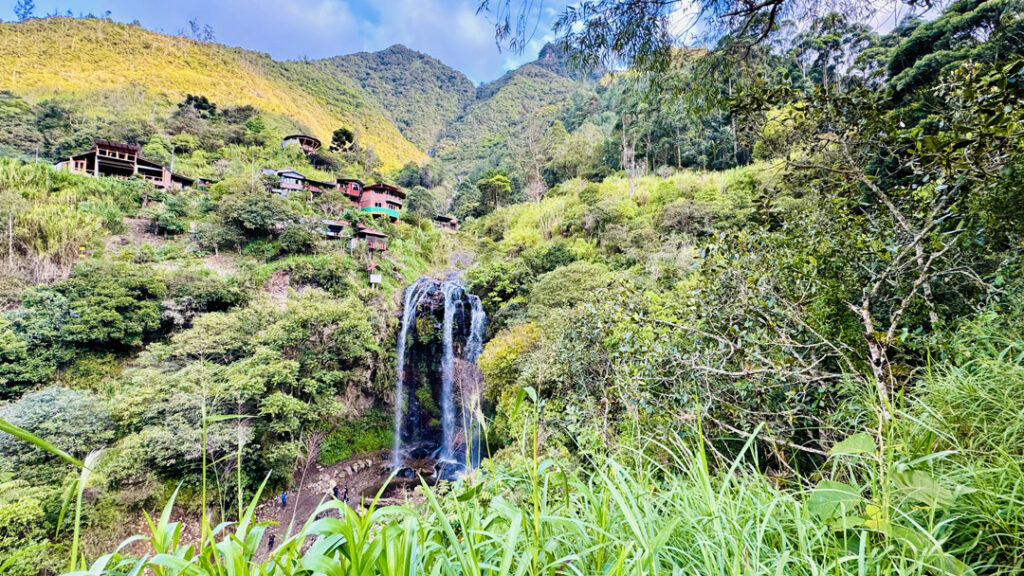
Known as the gateway to the Amazon, Baños Aguas de Santa is a beautiful area to explore the rainforest and waterfalls.
Why Ecuador is a Biodiversity Hot Spot
Ecuador’s exceptional biodiversity comes from its unique geographic location. This small South American country spans the equator (yes, you can visit the Mitad del Mundo- the center of the world just north of Quito!), the rugged Andes mountains, the Amazon rainforest, and the often desert-like Pacific coast. Finally, there are isolated islands of the Galápagos, where you can see animals found nowhere else on Earth!
A Rich History Shaped by Ancient Civilizations and Spanish Colonization
Before the Inca Empire took hold, over a dozen indigenous cultures thrived in Ecuador. The Quechua was the largest tribe and lived in the Andes mountain range. Each indigenous tribe maintained traditional customs and languages and farmed the lands as their ancestors had for centuries. The Inca civilization rose to power in 1463, however, their reign only lasted until the Spanish arrived in the mid-1500s, leading to nearly 300 years of colonial rule.
Spanish conquistadores and missionaries subdued the native communities, converted many Ecuadorians to Christianity, and subjected them to forced labor. The Spanish built churches over ancient temples and sacred spaces to establish dominance and facilitate the spread of Christianity. In addition, since the indigenous tribes had no immunity to diseases like smallpox, this led to a significant decline in their population.
Ecuador gained independence from Spain in 1822 and today celebrates both its indigenous roots and colonial influences. We recommend booking a city or cultural walking tour when you arrive in Quito. Connect with Jhonatan Quitilanda at Bacan Ecuador Tours to set up a private or group tour. Jhonatan met us at our hotel, and as we walked, he revealed the area’s deep traditions and cultural importance.
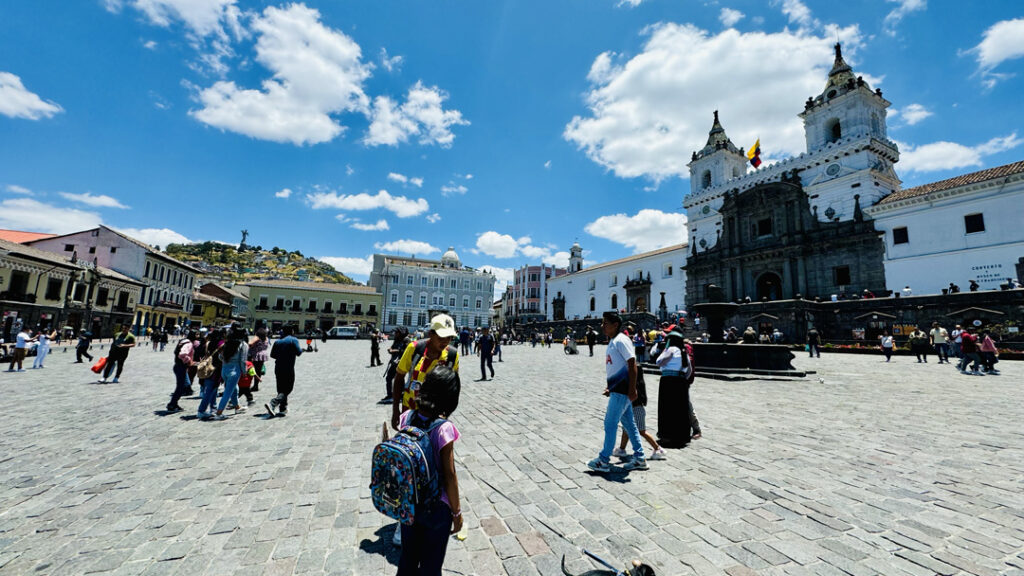
Walking around the Plaza de San Francisco in Quito’s historic city center.
Getting to Ecuador: Fly into Quito or Guayaquil
International flights to Ecuador will land in two major cities: Quito and Guayaquil. Quito’s Mariscal Sucre International Airport (UIO) is ideal for travelers who want to explore the Andes mountains and the Amazon. Guayaquil’s José Joaquín de Olmedo International Airport (GYE) is a bustling modern city, with an industrious coastal port that serves as a gateway to the Galapagos Islands. We learned quickly upon researching our trip that many travelers to Ecuador head straight to the Galapagos Islands and never leave the airport to visit mainland Ecuador. What an absolute shame! I vowed that our trip and the writing of this blog would help to promote the best outdoor activities in Ecuador in areas other than the Galapagos.
We flew into Quito to spend more time in the Andes and the Amazon. Quito is located at 9,000ft., it’s a UNESCO World Heritage Site, and its historic center is one of the largest and best-preserved colonial centers in Latin America! The city’s historic district is characterized by beautiful baroque architecture, charming plazas, and churches that showcase a blend of European and indigenous influences.
Travel tip: From Quito, you can drive an hour north to the town of Otavalo, known for its vibrant indigenous market!
Getting Around Ecuador: Private Shuttles, Tours, and Car Rentals
Once you arrive in Ecuador, you can easily find a taxi, private car, or a shuttle to bring you to your accommodations. You can also book in advance through your hotel or adventure tour operator to have someone meet you at the airport. In addition, the bus system connects all the major cities with smaller towns and is very inexpensive. However, it can take hours to reach your destination by bus. We also heard about petty theft in busy bus terminals and on the buses themselves, so be watchful of your belongings if you choose to go this route.
After visiting Quito, we rented a car and drove south along the Avenue of the Volcanos to reach Cotopaxi and Baños. Both Quito and Guayaquil have a few rental car agencies, however, do not expect the wide variety of cars nor the quick customer service you are used to in the States. Practice patience, and start practicing your Spanish at the rental counter!
Driving in Ecuador is not for the faint of heart. If you are comfortable driving in places like Mexico or Costa Rica, you’ll be fine here. If not, hire a driver or book day trips with a reputable tour operator like Rebecca Adventure Travel and let them worry about the cows on the road and oncoming traffic in your lane!
Travel tip: If you have limited time, instead of driving hours on sketchy mountain roads, opt for a short domestic flight between major hubs like Quito, Guayaquil, Cuenca, and Manta.
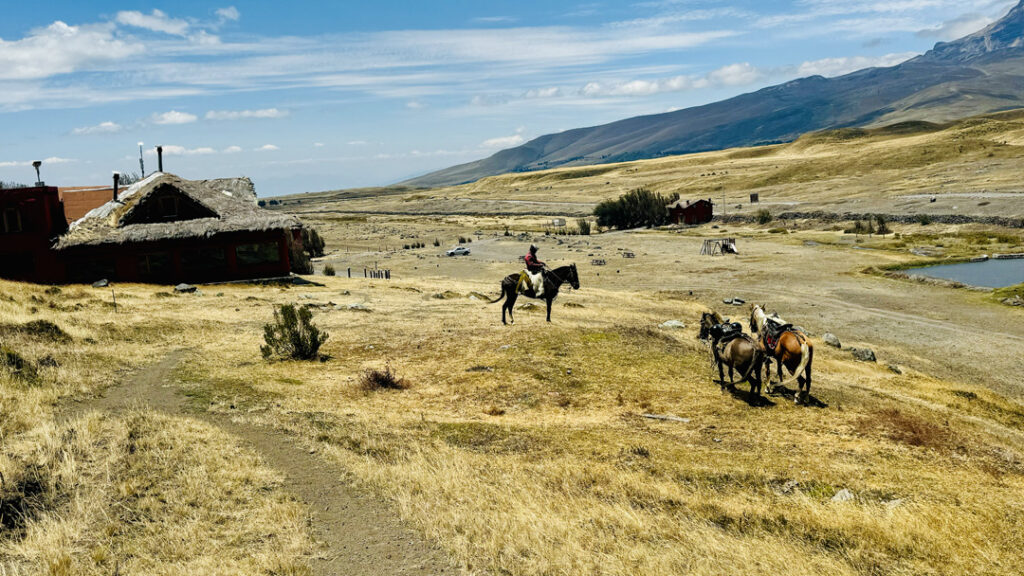
Try horseback riding from Tambopaxi Lodge in Cotopaxi National Park where you’ll have your own guide, a Chagra, a thick wool poncho to keep you warm, and endless views of the highlands and Cotopaxi!
Best Outdoor Activities in Ecuador
If you love getting outside in nature, whether that’s hiking, biking, or scuba diving, you will love Ecuador. Here are the best outdoor activities in Ecuador for adventurous travelers:
1. Hike in the Andes Mountains
The stunning Andes mountain range runs north to south down the center of Ecuador and is known for its high concentration of active volcanos. There are over 84 volcanos in Ecuador, with Cotopaxi being the most popular. Below are a few high-altitude treks you can do in the Andes, even if you do not plan on summiting a volcano.
Keep in mind, the peaks of most of Ecuador’s volcanos will be glaciated and require technical climbing skills along with the use of crampons and ice axes. If you do not have a lot of experience hiking at altitude, it’s best to book with a guide service or adventure tour operator. We’ve made some recommendations below.
Rucu Pichincha
Just to the west of Quito is Pichincha at 15,696 feet. It has two main peaks: Rucu Pichincha and Guagua Pichincha. Take the TelefériQo from Quito to gain 3,000 feet of elevation and begin your hike at 13,000 feet. This is a very doable, non-technical hike and you will not need a guide. However, you should be comfortable hiking at high altitudes with some good exposure, which you’ll encounter as you scramble the last few hundred feet to the summit! Even if you don’t make it to the summit, there are beautiful views from all the trails at the top of the teleférico, and you can also go horseback riding or meet alpacas!
Cotopaxi
Cotopaxi’s summit is at 19,347 feet, and can only be attempted with a guide. However, you can hike to the José Rivas Refugio on Cotopaxi at 15,958 feet without a guide. To do this, drive up to the car park at 15,000ft. Just getting up the switchbacks to the car park is an adventure in itself! We recommend getting a ride or having a 4-wheel drive. Once you step out of the car, you’ll quickly feel the altitude, and each step higher only becomes more challenging as you slog through volcanic soil. Plan on an hour to hike 1,000 feet to reach the José Rivas Refugio. Then take in the view while sipping a coffee or enjoying a meal before descending to the car park.
The José Rivas Refugio also serves as a base for climbers attempting to summit Cotopaxi, providing bunkrooms and hot meals. Climbers and their guides usually spend the night, rise before dawn, and make the final ascent to the summit. If summiting Cotopaxi is something you are interested in, contact Ramiro Garrido, an official IFMGA and UIAGM-certified mountain guide in Ecuador. We met Ramiro at Tambopaxi Lodge, and over shared meals, we learned so much about the region, the geology, and the guiding culture. Ramiro can help you organize an expedition, provide the best dates to visit, and suggest ways in which to prepare. Reaching the summit of Cotopaxi is never guaranteed, yet there is the potential to summit other volcanos such as Pichincha, Cayambe, or Antisana which are less demanding.
In addition to hiking Cotopaxi, there are many other day hikes and scenic lakeside trails to explore while visiting the park. We recommend staying at Tambopaxi Lodge as it’s the only accommodation within Cotopaxi National Park and it makes a great home base for acclimatizing, wildlife viewing, and horseback riding.
Chimborazo
Chimborazo is the tallest volcano in Ecuador at 20,548 feet and it’s located at the southern end of the Avenue of the Volcanos. Stay at the Chimborazo Lodge to explore the nearby hiking trails and wildlife.
Quilotoa Crater
The Quilotoa Loop is a high-altitude trek passing through remote Andean villages and ending at the breathtaking crater lake of Quilotoa. Stay nearby at the Hacienda La Alegria, a family horse farm near the Quilotoa Crater.
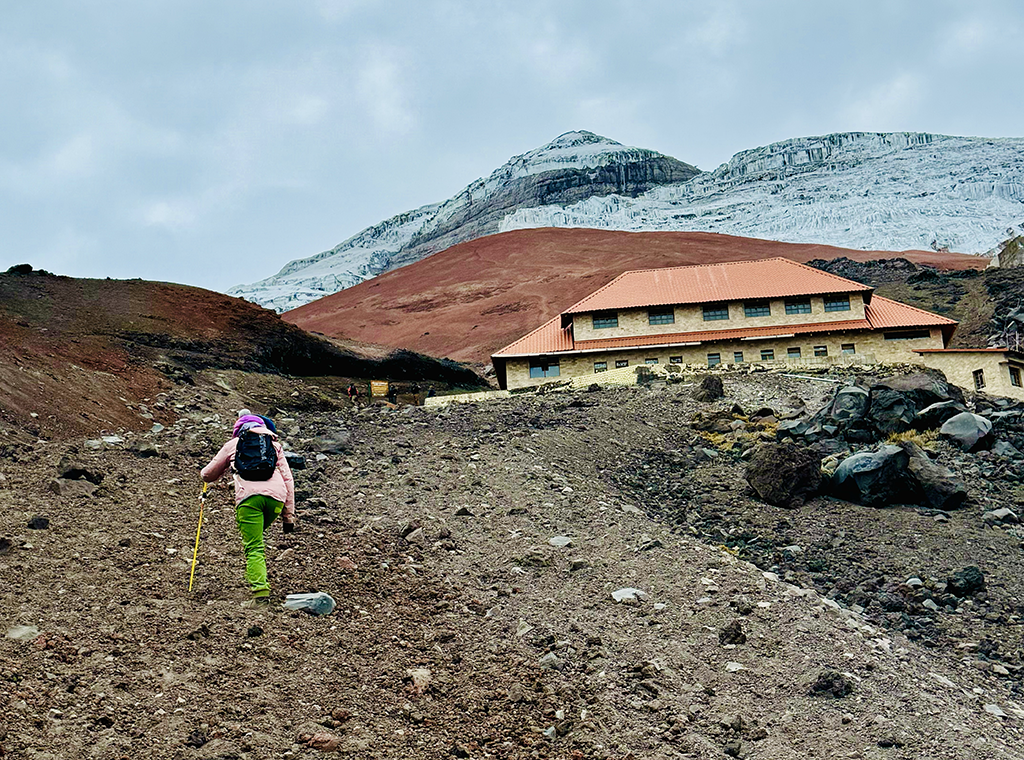
Hiking to the Jose Rivas Refugio on Cotopaxi is no small feat as you’ll gain 1,000 feet of elevation and top out at almost 16,000ft!
2. Explore the Amazon Rainforest
The Amazon Basin is among the most biodiverse regions on Earth and exploring here should be near the top of your best outdoor activities in Ecuador itinerary. If you love spotting wildlife, from howler monkeys and jaguars to pink river dolphins, you will enjoy exploring the Amazon rainforest.
The villages of Baños de Agua Santa and Tena are known as the “Gateways to the Amazon”. In both towns, you will find dozens of adventure tour operators like GeoTours who can organize day trips to go mountain biking, hiking, white-water rafting, or canyoneering! For those who want to go deeper into the Amazon, visit Cuyabeno Wildlife Reserve and Yasuni National Park.
Our favorite place to stay was just outside of Baños at Hosteria Finca Chamanapamba. This sprawling treehouse, built into the rainforest by a German family, is within walking distance to the Ruta de Las 7 Cascadas! You’ll fall asleep to the cacophony of jungle sounds and water flowing over the rocks just a few hundred feet away!
3. Hike to the Waterfalls Along La Ruta de Cascada
The area around Baños is also home to La Ruta de Las Cascadas, the Waterfall Route. Heading east from Baños towards Puyo, you’ll have about ten stops along La Ruta de Las Cascadas, each to visit a new waterfall. You can get there by car, by bike, or by bus to explore the waterfalls. Once you reach a stop, each waterfall will require lots of hiking, often down dozens of sketchy stairs built with MacGyver-like precision into the side of steep moss-covered cliffs. Our kind of type 2 fun!
In Baños you can rent mountain bikes, book with an adventure tour operator, or take your rental car as we did. Our favorite waterfall hike was to the Pailon Del Diablo or the Devil’s Cauldron, which you can check out here!
Instead of hiking to all the waterfalls in one day, enjoy your adventures over a couple of days and combine them with other activities like Tibetan bridge crossings, swinging at the Casa de Arbol, soaking in thermal hot springs, flying over the canyons in cable cars, or zip-lining. Exploring La Ruta de Las Cascadas was one of the best outdoor activities in Ecuador, and should be at the top of your adventure travel itinerary!
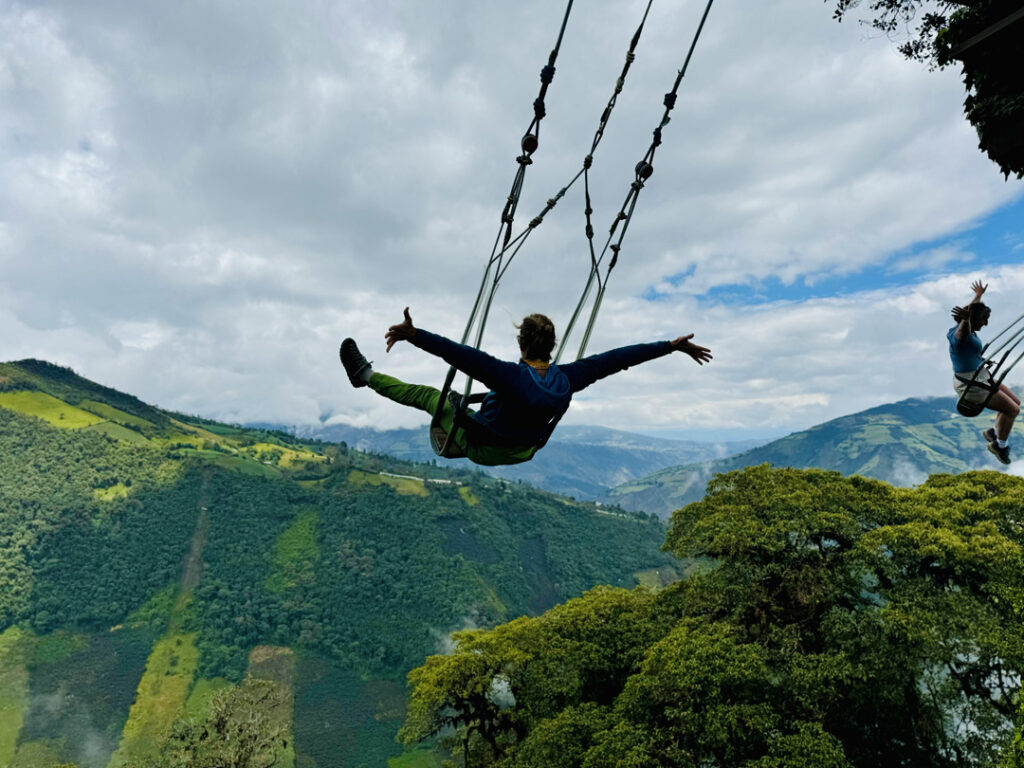
Make sure to drive up to what feels like the top of the world and check out the swings at Casa de Arbol!
4. Soak in Ecuador’s Hot Springs
In this region of volcanic activity, it’s no surprise that Baños is home to several thermal pools and hot springs. If you didn’t know, Baños de Agua Santa means ‘Baths of Holy Water,’ and the active Tungurahua volcano provides mineral-rich hot springs that can be easily accessed at two locations open to the public:
- Termas de La Virgen– located at the foot of la Virgen waterfall in the town of Baños
- Balneario El Salado– a smaller establishment with a more local vibe just west of Baños
In addition to these public locations, which charge a nominal fee and require you to wear a bathing cap, many hotels have pools heated by the thermal waters flowing through Baños from Tungurahua. Whichever you choose, a soak in the hot springs after a day of adventure feels extra special!
5. Go Birdwatching in the Mindo Cloud Forest
Exploring outdoor activities in Ecuador often means getting off the beaten path to more remote areas. Travel two hours from Quito to reach Mindo, a small village in the cloud forest known for its rich biodiversity. Here you can hike or ride cable cars high above the forest floor and spot dozens of different species of toucans, butterflies, and hummingbirds. You can also go zip-lining, hike to waterfalls, and visit the Yumbo Chocolate Factory!
Book a day trip from Quito to Mindo, or plan to stay overnight to fully immerse yourself in the cloud forest experience. If you want to stay, check out Hacienda San Vicente or “The Yellow House” which has hiking trails right from the property into the Mindo Cloud Forest.
6. Visit the Galápagos Islands
The Galápagos are a world-renowned destination for wildlife enthusiasts and marine adventurers. You can fill your days with outdoor activities like snorkeling with sea lions, scuba diving with hammerhead sharks, and meeting giant tortoises and blue-footed boobies. This protected island chain lies 600 miles off the coast of Ecuador, so a flight from the mainland is necessary.
There is a daily limit of visitors to the Galápagos Islands to maintain its rare and pristine environment. Therefore, you must book in advance. Once you arrive at the Galápagos, landing at the tiny airstrip in Baltra, you’ll often board a small 20-person cruise to reach the islands of Santa Cruz, San Cristobal, and others in the archipelago.
Travel tip: If traveling to the Galápagos doesn’t work with your itinerary, there are other places where you can snorkel or spot blue-footed boobies- keep reading to find out!
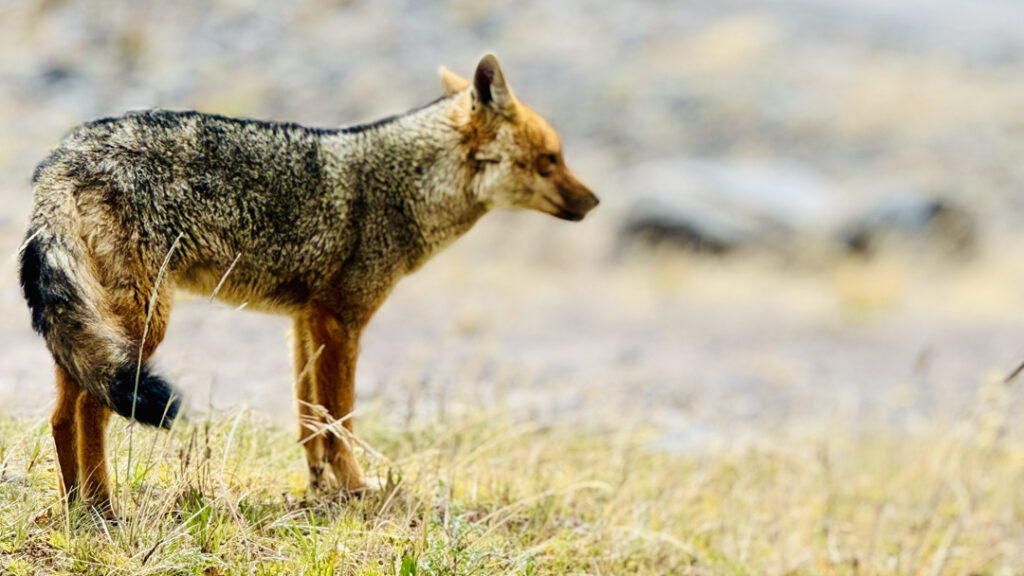
The opportunity to spot wildlife in Ecuador is incredible once you get off the beaten path. In the highlands along the Avenue of the Volcanos, look for Andean foxes!
7. Visit a Farm to See Llamas and Alpacas, and Go Horseback Riding
As you travel outside of the major cities in Ecuador’s Andes region, you will quickly enter rolling farmland and major agricultural areas. With its rich volcanic soil and diverse climate, Ecuador is a top producer of fruits and vegetables indigenous to the Andes. In addition, you’ll find most farms raising horses and cows, along with llamas and alpacas. Spotting a herd of llamas or alpacas in the Andean highlands is quite common as these animals are native to the region and are used by the indigenous communities of Ecuador. Even more modernized farms may raise alpacas and llamas for their prized wool or as pack animals to transport goods.
Alpacas in particular have risen in popularity and are quite the tourist attraction with their big expressive eyes, fluffy coats, and gentle demeanor. To guarantee a meet-and-greet with a herd of alpacas your best bet is to book a farm stay. Look for a ‘finca or hacienda‘. Hacienda Zuleta is a gorgeous working farm near Quito and Otavalo. In addition, El Cajas National Park outside of Cuenca or the Reserva de Produccion Faunistica Chimborazo (Chimborazo Wildlife Reserve) are great places to spot alpacas, llamas, and the elusive vicuñas and Andean foxes. Finally, there’s a herd of llamas in Quito roaming in Parque Metropolitano Guanguiltagua!
8. Surf, Scuba Dive, and Go Whale Watching on Ecuador’s Pacific Coast
Outdoor activities in Ecuador can also extend into the ocean and underwater. For surfers, there are several beach towns including Montañita, known for its lively atmosphere, and Ayampe a much quieter spot on the northern beaches. Here you can rent surfboards and take a lesson, or lie back, relax, and sip a margarita under a palapa! In addition, Los Frailes Beach, within Machalilla National Park, is another serene spot where you can snorkel right off the shore!
If you love marine life, stop in Puerto López and book a guided day trip to Isla de la Plata. Known as the poor man’s Galapagos, Isla de la Plata is a protected area located within Machalilla National Park, and is about two hours by boat from Puerto López. Once on Isla de la Plata, you can snorkel with green sea turtles and manta rays, or hike to see blue-footed boobies, Nazca boobies, giant frigates, and albatross. Visiting Isla de la Plata was the highlight of our time on the coast and we recommend booking with Machalilla Tours for snorkeling or scuba diving.
Travel tip: Visit between June through September to witness humpback whales making their annual migration from Antarctica to the nutrient-rich waters off Ecuador’s coastline.
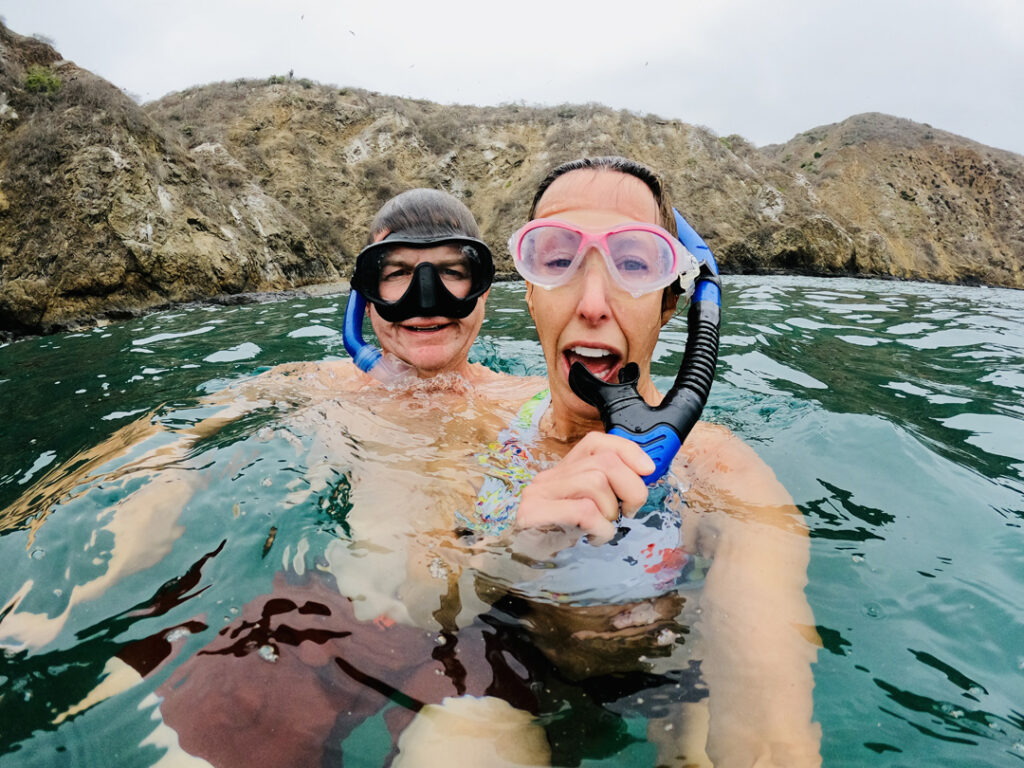
Snorkeling is one of the best outdoor activities to try if you’ll be on the coast and Machalilla Tours in Puerto Lopez can help you organize a day trip!
Outdoor Activities in Ecuador: Health Advisories and Safety
While enjoying outdoor activities in Ecuador, it’s essential to prioritize health and safety. If you’ve already begun your Ecuador travel searches, you’ll notice a lot of “Is it safe to travel to Ecuador?” blogs and forums. It’s a smart question to ask, as there has been a recent uptick in crime. Here is the answer to that ‘Is Ecuador safe’ question along with a few other questions to consider before you depart:
Is It Safe to Travel to Ecuador?
Ecuador has experienced a rise in crime, primarily due to escalating drug-related violence and gang activity. While not a major producer of illegal drugs, Ecuador is sandwiched between Peru to the south and Colombia to the north, both major cocaine-producing regions. Unfortunately, this contributes to the country’s role as a transit area for narcotics bound for international markets. Therefore, port cities like Guayaquil and Esmeraldas have seen significant crime and drug-related violence. In response, the Ecuadorian government has often implemented measures such as a nationwide state of emergency, nighttime curfews, and military checkpoints to protect its citizens.
While visiting Ecuador remains possible for international travelers, safety precautions are essential. Avoid high-risk areas in Guayaquil and Esmeraldas, do not travel alone or late at night, and share your travel details with the U.S. Department of State through their STEP Program to receive updates and advisories. When exploring, especially in busy cities or even remote regions, stick to organized tours with good reviews, and use trusted transportation. Pickpocketing and petty theft can occur in crowded areas and on public transport.
This is not the place to wear expensive clothes or jewelry. In addition, taking out your cell phone to take photos, navigate walking directions, or scroll through social media in busy city centers will only draw attention. Be smart and keep your valuables at home or in your hotel safe.
If it’s your first time traveling in Latin America, I recommend booking your outdoor activities in Ecuador through a tour operator like Rebecca Adventure Travel. They have years of experience and stellar reviews. We did not end up taking their tours, but their customer service was excellent, they answered every question we had, gave us sample itineraries, and went above and beyond!
How Can I Avoid Altitude Sickness?
Due to varying altitudes, especially in the Andes, be mindful of altitude sickness. It may start as a headache, dizziness, sleeplessness, or nausea. If you’ve never spent much time at high altitudes, acclimatize gradually and stay hydrated. Give yourself a day or two to adjust to the altitude, and remember, Quito is at 9,000 feet. Just walking up a flight of stairs to your room will feel like a big effort!
Do I Need Vaccinations for Ecuador?
If you only plan to visit the coast and stay in major cities like Guayaquil, Quito, and Cuenca, or visit the Galapagos Islands, you will not need vaccinations. However, vaccinations may be required if you will be visiting the Amazon. These may include yellow fever, malaria, and dengue fever, which are transmitted through mosquitoes. Check to see which ones you might need and if your healthcare provider offers this.
Yellow fever vaccine was recommended for our trip, and we quickly learned that not many pharmacies carry it. Schedule an appointment a few weeks before your trip to give the vaccine time to take effect. To help reduce mosquito bites while traveling, pack a good insect repellent and long-sleeved shirts and pants.
Can You Drink the Water in Ecuador?
Drink bottled or purified water while traveling in Ecuador. Tap water is not safe for drinking. Almost all reputable hotels, cafes, and restaurants serve bottled water or use purified water for making drinks and ice. Bottled water is very inexpensive, less than $1.00 for a large bottle, so always carry one with you.
What is Ecuador’s currency or exchange rate?
Ecuador uses the U.S. dollar, so as an American traveler, you will not need to change money upon arrival. This surprises and delights most travelers! There are ATMs in most city centers and the cost of goods is much less than you will find in the U.S. However, whether it’s accommodations, meals, or transportation, most Ecuadorians prefer cash. Carry small bills and get change. You’ll be using a lot of $1 coins and fifty-cent pieces, and no one ever has change for a twenty!
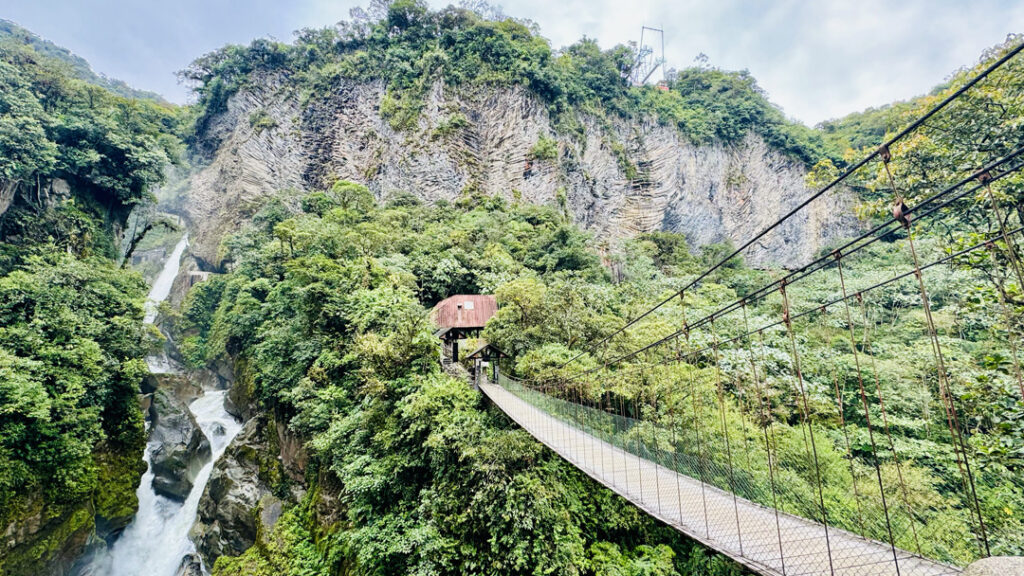
Walk across suspension bridges high above the jungle floor in Baños while exploring La Ruta de Cascadas.
Outdoor Activities in Ecuador: Final Thoughts on the Local Culture and Cuisine
The best outdoor activities in Ecuador have something for everyone. While exploring, remember to try all the local cuisine. After a cold, blustery hike to the Jose Rivas Refugio at Cotopaxi, our first few bites of Locro de Papa were outstanding! We went on to eat this creamy potato soup, garnished with cheese, avocado, and a side of crusty bread daily at Tambopaxi Lodge. If you’re in the coastal towns of Montanita or Puerto Lopez, you can’t go wrong with ceviche and a cerveza after a surf or whale-watching tour. The fish is often caught fresh that day!
In addition, the floral and fruity aroma of every cup of Ecuadorian coffee was incredible and gave us that extra boost before a morning hike. And the chocolate!! Most of the cacao is grown near the coast at small organic farms or cacao plantations that you can visit. If you’ll be in Quito, make an appointment to visit Yumbos Chocolate Shop for a tasting or visit their factory in Mindo.
Slow down after an action-packed morning and get to know the locals. Practice your Spanish! Book tours with guides that can give you a bit of history while taking you on an adventure. We hope you enjoyed this blog, it’s one of our longest to date, but we didn’t want to leave anything out! If you want more travel tips to international locations, here are a few to check out:
Thanks for reading and happy traveling,
Meredith, Top Rope Media
Recent Comments